Hugo Laurençon
Building and better understanding vision-language models: insights and future directions
Aug 22, 2024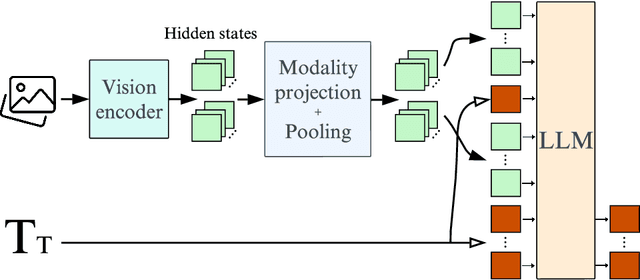
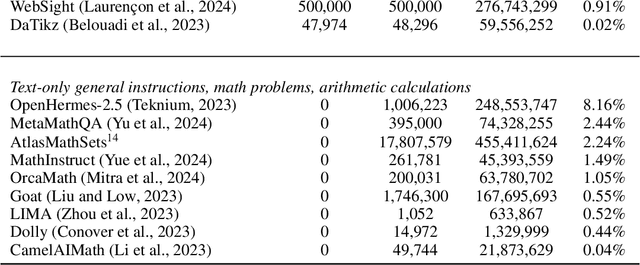


Abstract:The field of vision-language models (VLMs), which take images and texts as inputs and output texts, is rapidly evolving and has yet to reach consensus on several key aspects of the development pipeline, including data, architecture, and training methods. This paper can be seen as a tutorial for building a VLM. We begin by providing a comprehensive overview of the current state-of-the-art approaches, highlighting the strengths and weaknesses of each, addressing the major challenges in the field, and suggesting promising research directions for underexplored areas. We then walk through the practical steps to build Idefics3-8B, a powerful VLM that significantly outperforms its predecessor Idefics2-8B, while being trained efficiently, exclusively on open datasets, and using a straightforward pipeline. These steps include the creation of Docmatix, a dataset for improving document understanding capabilities, which is 240 times larger than previously available datasets. We release the model along with the datasets created for its training.
What matters when building vision-language models?
May 03, 2024Abstract:The growing interest in vision-language models (VLMs) has been driven by improvements in large language models and vision transformers. Despite the abundance of literature on this subject, we observe that critical decisions regarding the design of VLMs are often not justified. We argue that these unsupported decisions impede progress in the field by making it difficult to identify which choices improve model performance. To address this issue, we conduct extensive experiments around pre-trained models, architecture choice, data, and training methods. Our consolidation of findings includes the development of Idefics2, an efficient foundational VLM of 8 billion parameters. Idefics2 achieves state-of-the-art performance within its size category across various multimodal benchmarks, and is often on par with models four times its size. We release the model (base, instructed, and chat) along with the datasets created for its training.
Unlocking the conversion of Web Screenshots into HTML Code with the WebSight Dataset
Mar 14, 2024Abstract:Using vision-language models (VLMs) in web development presents a promising strategy to increase efficiency and unblock no-code solutions: by providing a screenshot or a sketch of a UI, a VLM could generate the code to reproduce it, for instance in a language like HTML. Despite the advancements in VLMs for various tasks, the specific challenge of converting a screenshot into a corresponding HTML has been minimally explored. We posit that this is mainly due to the absence of a suitable, high-quality dataset. This work introduces WebSight, a synthetic dataset consisting of 2 million pairs of HTML codes and their corresponding screenshots. We fine-tune a foundational VLM on our dataset and show proficiency in converting webpage screenshots to functional HTML code. To accelerate the research in this area, we open-source WebSight.
CALM : A Multi-task Benchmark for Comprehensive Assessment of Language Model Bias
Aug 24, 2023Abstract:As language models (LMs) become increasingly powerful, it is important to quantify and compare them for sociodemographic bias with potential for harm. Prior bias measurement datasets are sensitive to perturbations in their manually designed templates, therefore unreliable. To achieve reliability, we introduce the Comprehensive Assessment of Language Model bias (CALM), a benchmark dataset to quantify bias in LMs across three tasks. We integrate 16 existing datasets across different domains, such as Wikipedia and news articles, to filter 224 templates from which we construct a dataset of 78,400 examples. We compare the diversity of CALM with prior datasets on metrics such as average semantic similarity, and variation in template length, and test the sensitivity to small perturbations. We show that our dataset is more diverse and reliable than previous datasets, thus better capture the breadth of linguistic variation required to reliably evaluate model bias. We evaluate 20 large language models including six prominent families of LMs such as Llama-2. In two LM series, OPT and Bloom, we found that larger parameter models are more biased than lower parameter models. We found the T0 series of models to be the least biased. Furthermore, we noticed a tradeoff between gender and racial bias with increasing model size in some model series. The code is available at https://github.com/vipulgupta1011/CALM.
OBELISC: An Open Web-Scale Filtered Dataset of Interleaved Image-Text Documents
Jun 21, 2023



Abstract:Large multimodal models trained on natural documents, which interleave images and text, outperform models trained on image-text pairs on various multimodal benchmarks that require reasoning over one or multiple images to generate a text. However, the datasets used to train these models have not been released, and the collection process has not been fully specified. We introduce the OBELISC dataset, an open web-scale filtered dataset of interleaved image-text documents comprising 141 million web pages extracted from Common Crawl, 353 million associated images, and 115 billion text tokens. We describe the dataset creation process, present comprehensive filtering rules, and provide an analysis of the dataset's content. To show the viability of OBELISC, we train an 80 billion parameters vision and language model on the dataset and obtain competitive performance on various multimodal benchmarks. We release the code to reproduce the dataset along with the dataset itself.
The BigScience ROOTS Corpus: A 1.6TB Composite Multilingual Dataset
Mar 07, 2023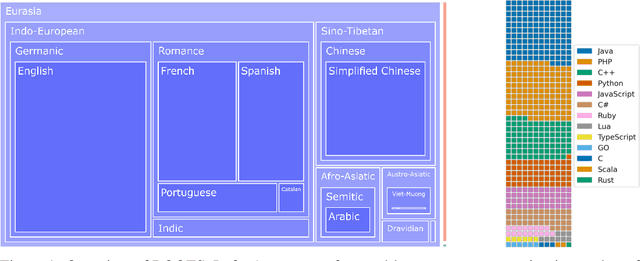



Abstract:As language models grow ever larger, the need for large-scale high-quality text datasets has never been more pressing, especially in multilingual settings. The BigScience workshop, a 1-year international and multidisciplinary initiative, was formed with the goal of researching and training large language models as a values-driven undertaking, putting issues of ethics, harm, and governance in the foreground. This paper documents the data creation and curation efforts undertaken by BigScience to assemble the Responsible Open-science Open-collaboration Text Sources (ROOTS) corpus, a 1.6TB dataset spanning 59 languages that was used to train the 176-billion-parameter BigScience Large Open-science Open-access Multilingual (BLOOM) language model. We further release a large initial subset of the corpus and analyses thereof, and hope to empower large-scale monolingual and multilingual modeling projects with both the data and the processing tools, as well as stimulate research around this large multilingual corpus.
The ROOTS Search Tool: Data Transparency for LLMs
Feb 27, 2023


Abstract:ROOTS is a 1.6TB multilingual text corpus developed for the training of BLOOM, currently the largest language model explicitly accompanied by commensurate data governance efforts. In continuation of these efforts, we present the ROOTS Search Tool: a search engine over the entire ROOTS corpus offering both fuzzy and exact search capabilities. ROOTS is the largest corpus to date that can be investigated this way. The ROOTS Search Tool is open-sourced and available on Hugging Face Spaces. We describe our implementation and the possible use cases of our tool.
BLOOM: A 176B-Parameter Open-Access Multilingual Language Model
Nov 09, 2022Abstract:Large language models (LLMs) have been shown to be able to perform new tasks based on a few demonstrations or natural language instructions. While these capabilities have led to widespread adoption, most LLMs are developed by resource-rich organizations and are frequently kept from the public. As a step towards democratizing this powerful technology, we present BLOOM, a 176B-parameter open-access language model designed and built thanks to a collaboration of hundreds of researchers. BLOOM is a decoder-only Transformer language model that was trained on the ROOTS corpus, a dataset comprising hundreds of sources in 46 natural and 13 programming languages (59 in total). We find that BLOOM achieves competitive performance on a wide variety of benchmarks, with stronger results after undergoing multitask prompted finetuning. To facilitate future research and applications using LLMs, we publicly release our models and code under the Responsible AI License.
DP-Parse: Finding Word Boundaries from Raw Speech with an Instance Lexicon
Jun 22, 2022



Abstract:Finding word boundaries in continuous speech is challenging as there is little or no equivalent of a 'space' delimiter between words. Popular Bayesian non-parametric models for text segmentation use a Dirichlet process to jointly segment sentences and build a lexicon of word types. We introduce DP-Parse, which uses similar principles but only relies on an instance lexicon of word tokens, avoiding the clustering errors that arise with a lexicon of word types. On the Zero Resource Speech Benchmark 2017, our model sets a new speech segmentation state-of-the-art in 5 languages. The algorithm monotonically improves with better input representations, achieving yet higher scores when fed with weakly supervised inputs. Despite lacking a type lexicon, DP-Parse can be pipelined to a language model and learn semantic and syntactic representations as assessed by a new spoken word embedding benchmark.
Continuous Homeostatic Reinforcement Learning for Self-Regulated Autonomous Agents
Sep 14, 2021
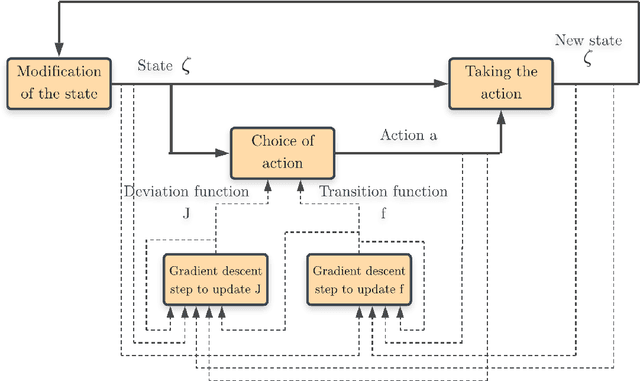
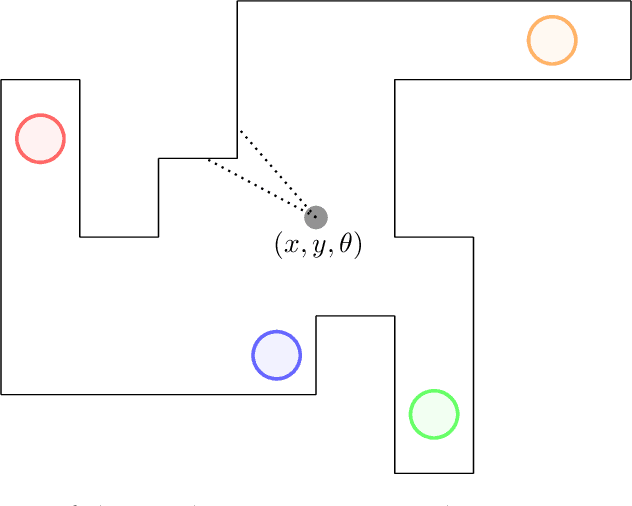

Abstract:Homeostasis is a prevalent process by which living beings maintain their internal milieu around optimal levels. Multiple lines of evidence suggest that living beings learn to act to predicatively ensure homeostasis (allostasis). A classical theory for such regulation is drive reduction, where a function of the difference between the current and the optimal internal state. The recently introduced homeostatic regulated reinforcement learning theory (HRRL), by defining within the framework of reinforcement learning a reward function based on the internal state of the agent, makes the link between the theories of drive reduction and reinforcement learning. The HRRL makes it possible to explain multiple eating disorders. However, the lack of continuous change in the internal state of the agent with the discrete-time modeling has been so far a key shortcoming of the HRRL theory. Here, we propose an extension of the homeostatic reinforcement learning theory to a continuous environment in space and time, while maintaining the validity of the theoretical results and the behaviors explained by the model in discrete time. Inspired by the self-regulating mechanisms abundantly present in biology, we also introduce a model for the dynamics of the agent internal state, requiring the agent to continuously take actions to maintain homeostasis. Based on the Hamilton-Jacobi-Bellman equation and function approximation with neural networks, we derive a numerical scheme allowing the agent to learn directly how its internal mechanism works, and to choose appropriate action policies via reinforcement learning and an appropriate exploration of the environment. Our numerical experiments show that the agent does indeed learn to behave in a way that is beneficial to its survival in the environment, making our framework promising for modeling animal dynamics and decision-making.
 Add to Chrome
Add to Chrome Add to Firefox
Add to Firefox Add to Edge
Add to Edge